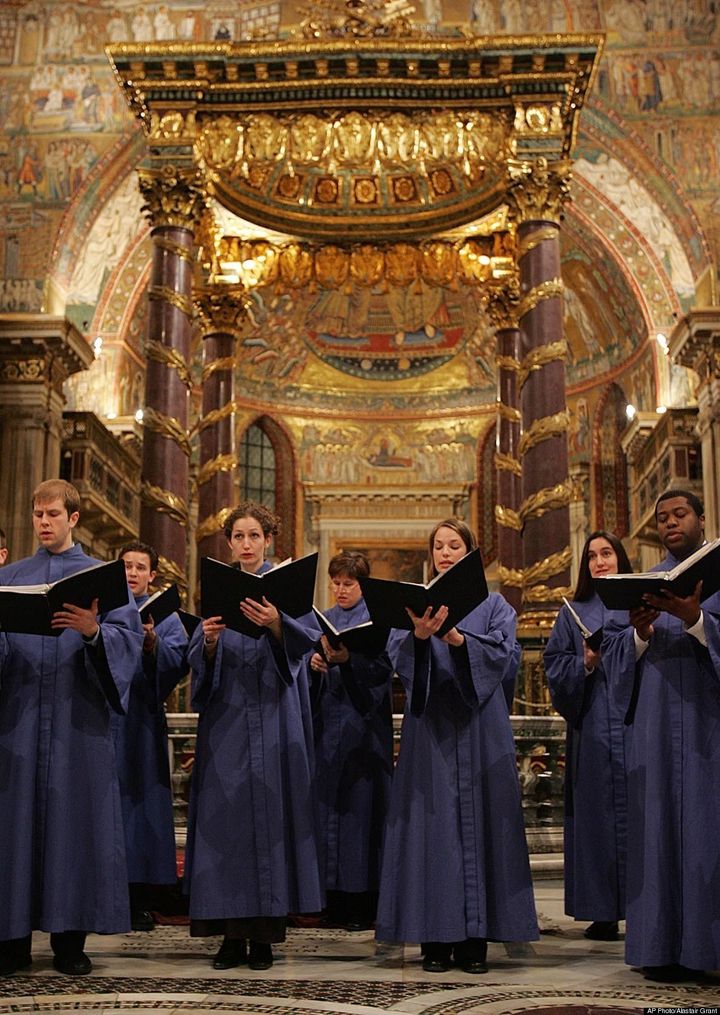
The musical arts of the Roman Catholic Church rank among its greatest contributions to contemporary culture. Music existed outside of the Church, of course. But it was the Catholic Church that first truly cultivated the art as we know it. In the service of praising God, it fostered a number of innovations -- such as musical notation -- that inform the ways we create and transmit music even today.
Take, for instance, the musical scale rendered in syllables as "do re mi fa sol la ti do." This arrangement of precise pitch relationships is the basis of a clever song in The Sound of Music ("Do -- a deer, a female deer. Re -- a drop of golden sun ... ") and, indeed, of virtually every piece of music that sounds "in tune" to the average ear in Western European and American cultures. These particular pitch relationships (and the idea of rendering them as syllables) were harnessed from all existing sound by a resourceful Benedictine monk named Guido of Arezzo in the early eleventh century. Guido's scale had only six notes (ut, re, mi, fa, sol, la) but with just a slight modification (changing "ut" to "do" in a later century) and the addition of "ti" (that brings us back to "do") the basic form remains unchanged nearly 1000 years later. So does its purpose. Then, as now, the scale served to help singers learn and recall a body of songs whose sheer quantity made them increasingly difficult to memorize and pass down.
Guido's scale had a "sacred origin" of sorts; at least in terms of the context from which it was derived. The monk drew his inspiration for the musical scale he devised from a hymn sung on the feast of St. John the Baptist (Ut queant laxis) that suggested to him the pattern of ascending notes (and the relative pitches that occur between them) that we still use today. The specifics of how Guido got from "point A" to "point B" need not detain us here. (Although it is an interesting story!) Suffice it to say that any song written down with the basic musical scale Guido first devised nearly a millenium ago -- whether it is sung by a Benedictine monk, Julie Andrews, or Lady Gaga -- reflects just one aspect of the Catholic Church's great legacy of cultivating music in the service of God -- the invention of a musical staff with precise pitch arrangements that help us to create, perform, and remember most of the melodies we enjoy today -- inside the Church and out.
It should not surprise us that music has been such a central concern for the Church. Indeed, praying through music allows us to express our highest calling -- to come together as a community to worship and praise God -- in a way that no other art can. Painting, sculpture, and architecture might spur us toward holiness, but none can unite us quite like music. This is particularly true of singing -- an art that invites group participation and can often arise spontaneously around a shared sentiment and a decent tune.
Singing is a natural response in times of joy or mourning, stress or relaxation -- even in times of sheer boredom. It is universally accessible in that -- all aesthetic judgements aside -- if you can talk, you can sing. In the most general sense, we might think of singing merely as heightened speech: an inflection here, a thoughtful pause there, a lilting cadence to accentuate related ideas. Plot those inflections, pauses and cadences onto a graph indicating relative time and pitch (that is essentially what sheet music does) and heightened speech is transformed into song.
St. Augustine was one of music's earliest eloquent proponents. (He is popularly credited with coining the phrase "He who sings, prays twice.") Today, Pope Benedict XVI, an accomplished pianist and brother of Msgr. Georg Ratzinger (former director of the Regensburg Cathedral Choir), has emerged as one of the most thoughtful commentators on sacred music since then. (I highly recommend his essay on music in The Spirit of the Liturgy, Ignatius Press, 2000.) In some recent remarks, Pope Benedict extended his advocacy of music beyond the realm of the sacred (strictly speaking), lauding it as a valuable tool in the educational process. Addressing the Fiesole Youth Orchestra after a concert in Vatican City last year, he praised the young musicians, noting their "constant practices carried out with patience; the exercise of listening to the other musicians; the commitment not to play 'in solitude'," but in a way that allowed the different orchestral colors to come together while maintaining their own characteristics. In fine, he praised their "common search for the best expression."
The Holy Father was addressing a youth orchestra there, but his words resonate with the whole of humanity: Don't play alone. Come together. Listen to one another. Maintain your own characteristics in the common search for the best expression. Those are the basic rules for living in harmony -- an ideal for society that is rehearsed in our churches every Sunday, and never more so than when we come together as a community to pray through sacred song. Guido of Arezzo could not have foreseen the far-reaching consequences of the singing aids he devised in the eleventh century. But we can easily imagine that he would have been pleased. Laus Deo.